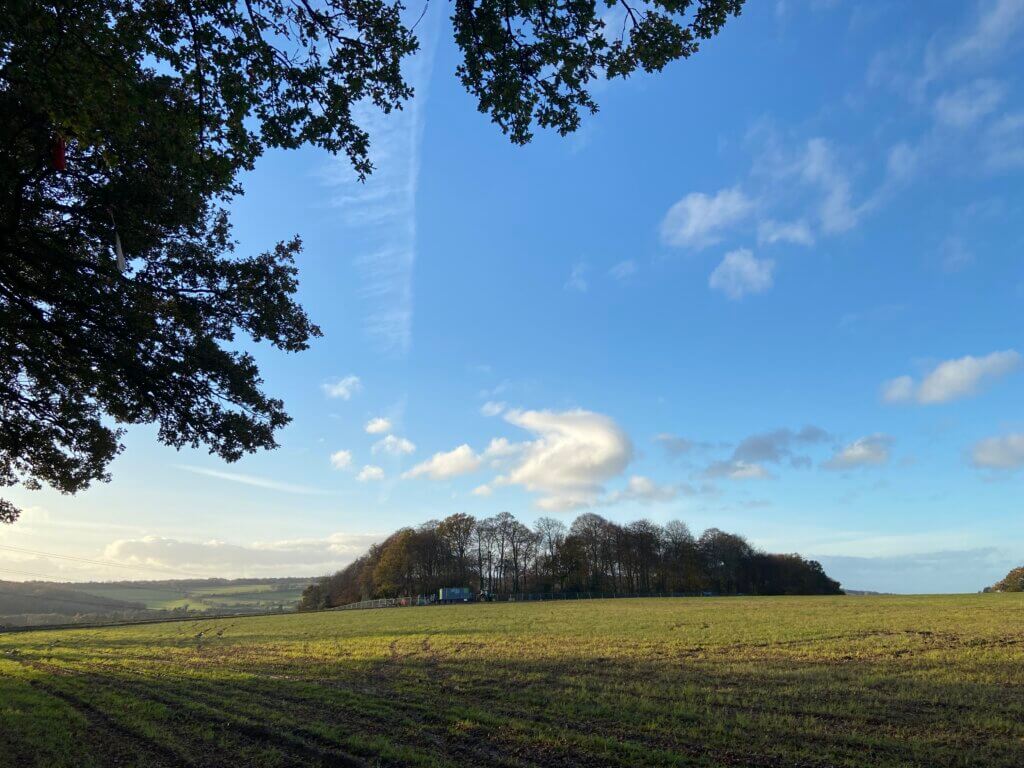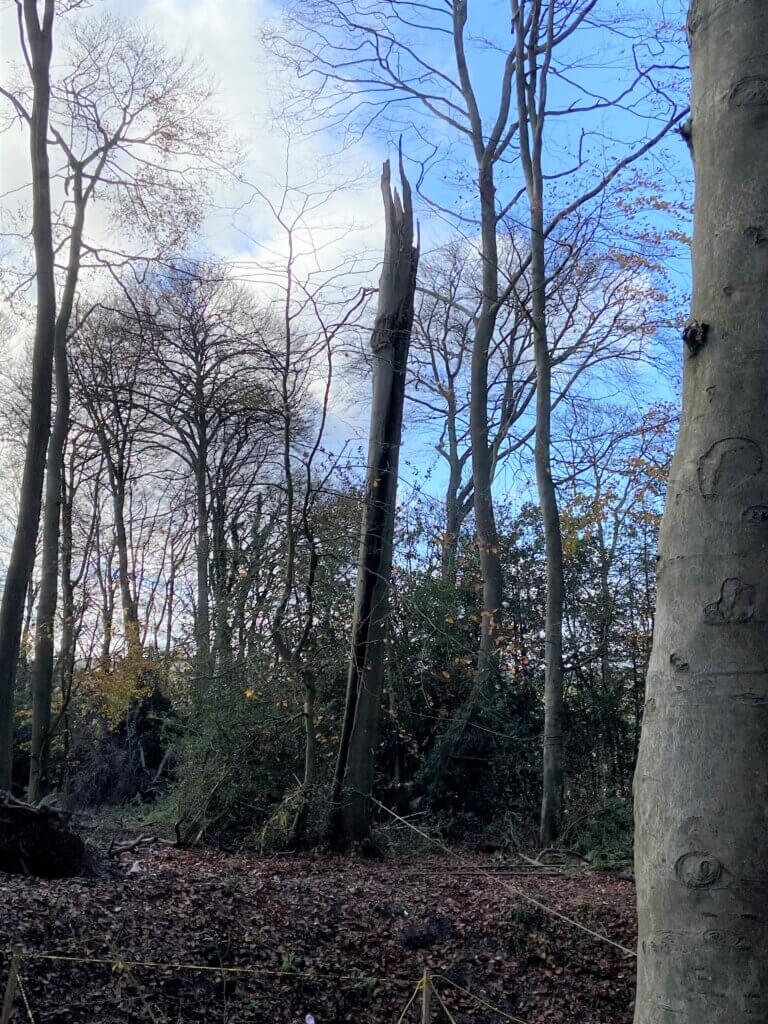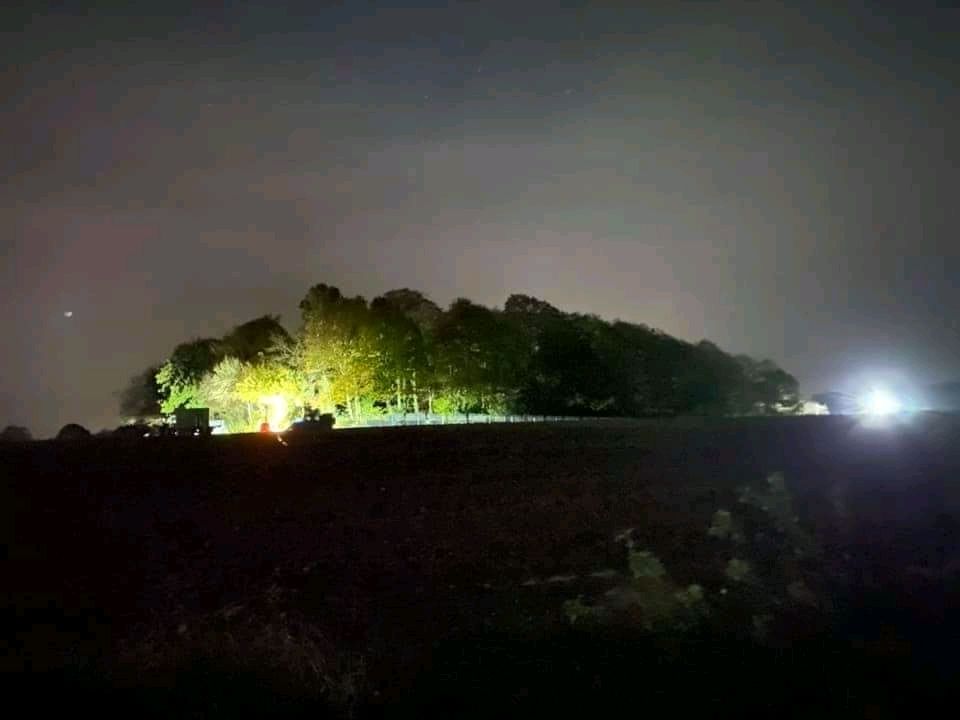
Dominic Woodfield is the Managing Director of Bioscan, a long established and well-respected consultancy specialising in applied ecology.
He is a life-long birder, a specialist in botany, habitat restoration and creation and in protected fauna including bats, herpetofauna and other species. He is also a highly experienced practitioner in Environmental Impact Assessment and Habitats Regulations Assessment. Most of his work is for the development sector, but he has also undertaken commissions for Natural England, the RSPB, Wildlife Trusts and campaign groups. He once mounted an independent legal challenge in defence of an important site for butterflies in Bicester, Oxfordshire, which resulted in planning permission for a five-hundred unit housing development being overturned. He lives in Oxford with his partner and family.

Jones Hill Wood shortly after the eviction of protestors in October 2020. The left-hand half of the wood as visible in this photo will be removed by HS2. Photo: Dominic Woodfield
Jones Hill Wood is an ancient semi-natural woodland sitting atop a gentle hill in the countryside north of Great Missenden in the Buckinghamshire Chilterns. That village was the home of the celebrated Roald Dahl and Jones Hill Wood is part of the countryside around it that inspired tales such as Fantastic Mr Fox. Much of Fantastic Mr Fox concerns the flight of woodland denizens from the wrath and the diggers of farmers Boggis, Bunce and Bean (the farm adjoining Jones Hill Wood is still owned by a Mr Bunce). The story ends with the farmers miserably but tenaciously waiting for Mr Fox to emerge from a hole at the bottom of a crater that is all that’s left of his devastated home, unaware that the wily hero has outwitted them by creating a far-reaching underground tunnel network that the reader is left confidently thinking will allow the woodland creatures to survive the siege.
There is now a new cast of characters playing out a story of wildlife versus diggers in the countryside around Roald Dahl’s home. The scenes today at Jones Hill Wood could be straight out of the illustrations of Roald Dahl’s book or its successful animated film adaptation, but the villains Boggis, Bunce and Bean have been replaced by HS2 Ltd and Natural England. Adding to the pantheon of characters in this 21st Century version are a group of protestors, local residents and politicians, NGOs, concerned independent ecologists and lawyers. Some are wholly unconvinced that destroying around half of Jones Hill Wood to create one side of a railway cutting is an acceptable price to pay for the delivery of the new high-speed line. Others are merely horrified at the way HS2 are going about it and by the complicity and lack of backbone that appears to be being shown by the regulator Natural England in holding HS2 Ltd to account, despite its promises of exemplary environmental standards.
Last autumn, the battle to save Jones Hill Wood came to the first of many recent crunch points when protestors who had occupied the wood with the consent of the landowner for much of 2020 were forcibly evicted by HS2 as a precursor to felling and clearing the site. The protestors had not used their time idly, and claimed to have collected evidence of bat roosts, including a roost of the rare barbastelle bat. As HS2 geared up to fell the woodland, the advice of ecological professionals and lawyers was sought and despite problems with disclosure it quickly emerged that HS2 had failed to carry out any proper surveys of bats to establish what mitigation was required to comply with their strict protection under UK and European law. “Hold up!”, I hear you say. “They had not bothered to survey an ancient woodland properly for the presence of bats? Are there any more likely places bats could be?” But it is true. ‘Cavalier’ is how I described the position when I was contacted in October 2020 and first asked to look at the standards of information produced by HS2. I now think that was overly generous.
Step forward the Woodland Trust whose CEO Darren Moorcroft described HS2’s intention to fell ancient woodland without proper bat surveys or a bat licence as tantamount to “bulldozing a church or listed building without even looking what’s inside it”. Drawing on advice and witness evidence from myself and others that it was statistically inconceivable that an area of ancient woodland of this size would not contain bat roosts, they put HS2 on notice that they were poised to legally challenge, by means of seeking an injunction if necessary, any decision to fell the wood without proper surveys. Disapproval or concern was also expressed from other NGO quarters, albeit with varying degrees of vigour. Questions were raised in Parliament and The House of Lords. And Natural England were quite rightly asked pointed questions about their role in facilitating or failing to properly regulate all of this.

A standing dead beech tree with high potential for roosting bats in the part of Jones Hill Wood to be felled. Photo: Dominic Woodfield
The mounting clamour to do the right thing eventually became too difficult for HS2 to ignore. It became evident by the lack of felling that Jones Hill Wood was being given an unofficial reprieve. We now know that this was in part because HS2 scrambled its hired ecologists to get out during October and November to try and patch up the baseline dataset with further survey work. Not only was this the wrong time of year for effective bat surveys, but by this point the woodland had suffered weeks of constant security presence, removal of ground flora and understorey and the deployment of high-powered lighting angled up into the trees – lighting that could be seen for miles across the Chilterns and cannot have done anything other than displace more light sensitive bats from the wood and disturb those others that tried to return to their roosts regardless. Such disturbance of roosts is an offence under the law, but only if it can be proven – such proof being a high bar that HS2 has consistently pointed at with a proverbial wink and a smile. As the protestors and others have found, it is very difficult to prove wildlife offences are taking place on a site that you cannot get anywhere near due to intense security.

Despite multiple requests, HS2 have consistently failed to release information about survey results, methodologies, mitigation and other matters, with Natural England dragging their feet through the FOI process at every turn. However, from what information has filtered through the latter route, the following has been learned. It emerged in March 2021 that surveys by HS2 over the winter of 2020/21 had indeed found a winter roosting site for soprano pipistrelle bats. Here was the proof that if HS2 had been successful in its intentions to fell the wood the previous autumn, offences would have been committed. Any contrition from HS2? No. Any sharp intake of breath from NE? No.
So, it was now beyond dispute that a licence was required – vindicating the protestors’ and Woodland Trust’s position. But how do you apply for a licence when you have failed by your own incompetence or disregard to meet the minimum survey requirements over the countless survey opportunities you have had in the seven years since you were granted permission for a project, and then find that it is still too early in the year to carry out such surveys?
Step forward Natural England, holding open and beckoning you towards a side door that lets you circumvent this problem. This is in the shape of something called licensing policy 4 (LP4). LP4 allows NE to accept educated guesswork to bridge the gap between industry standard or otherwise adequate surveys and the level of information required for sufficient certainty in the licensing process. According to NE’s own guidance, it is expressly intended for use in “simple” situations where there are good, justifiable reasons why the surveys are not as good as they should be and where more common species whose requirements are better known are concerned.
Using LP4, HS2 applied in early 2021 for a licence to cover bat offences at Jones Hill Wood based on a worst-case scenario that the wood contained roosts of a broad range of bat species, including the rare barbastelle, and multiple individuals of those species.
Let’s stop for a second to consider how far HS2 have been dragged. Their position in October 2020 was that there were no bat constraints at Jones Hill Wood sufficient to prevent them clearing the site there and then. Their position is now that numerous roosts, including breeding roosts of rare species, might be destroyed. Why would they change their position so comprehensively – could it be a case of “say whatever you think will get you a licence”?
Evidently, yes. Because Natural England have indeed granted a licence covering impacts up to and including the loss of multiple roosts and the loss of breeding sites for three bat species (see https://naturalengland.blog.gov.uk/2021/03/31/bat-licensing-at-jones-hill-wood/). The mitigation and compensation for these impacts involves putting up a few bat boxes, and significant reliance on future measures that will take decades to be delivered. A breeding roost of barbastelle bats adequately compensated (such that there is no net negative effect on local populations of this rare species) by sticking up some bat boxes? Is there a proven instance of this cursory level of compensation for this type of roost and this species working? I know of none.
With the licence issued last week, the tree fellers moved in on Jones Hill Wood this morning, 6th April 2021. By the time you read this, the woodland may be felled.
What is the takeaway message from this? Quite clearly, it is that as long as your project is sufficiently big enough that you can bully Natural England, you needn’t bother complying with adequate wildlife surveys or indeed other minimum industry standards. Just paint a worst case and commit to unproven or long-into-the-future mitigation and compensation measures and that will get you past the regulatory hurdle. Want to take down this line of trees full of old woodpecker holes? I’ve done no bat surveys but I will mitigate on the basis that a barbastelle breeding roost is present. Taking my lead from the Jones Hill Wood licence, this means I need do no more than stick up some bat boxes over there. Fine, here’s your licence.
The basic premise behind licensing policy 4 – that there must be allowance for situations where impacts can be confidently predicted even when survey standards have not been able to be met – is eminently sensible. But the problem with any such policy is guarding against its abuse. By issuing HS2 with a bat licence for Jones Hill Wood in the manner in which they have, Natural England have demonstrated that they will not block such abuse. Their approach to protected species licensing is instead rapidly descending into rubber stamping giant leaps of faith. Licensing decisions are becoming based not on “we are absolutely confident this mitigation is proven and will work” but “we feel there’s a chance this mitigation could work”. That represents a departure from both the spirit and the letter of the Habitats Directive and the UK Regulations that still, post-Brexit, seek to enforce it, and may yet be challenged in the courts. And what message does it send to other developers and householders with a bat issue?
When Boggis, Bunce and Bean pursued their quarrel with Fantastic Mr Fox and their diggers destroyed his wood, Roald Dahl did not feel any need to write about licenses and wildlife crime. The story unfolds in a mid-20th Century world entirely unfettered by regulation or intervention from a government nature agency. It is hard not to conclude that we are heading back towards this point. And one alarming question remains hanging: if HS2 were so close to getting away with wildlife crime at the well-watched Jones Hill Wood, what the hell is happening at the countless other woods, hedgerows and mature trees affected elsewhere along the route?

It is very sad to see so much wilful destruction of nature and our wildlife all for the sake of arriving at Leeds ten minutes or twenty minutes earlier than one can now. It is the logic of the madhouse. This is especially so as while we are forced to watch so much destruction, HS2 is becoming redundant right now with the rapid developments in computer technology like Zoom, when one can hold meetings and discussions on line without having to travel at all.
I think one has to realise that in fact this Tory Government, together with HS2 Ltd and Natural England are all one of the same rotten organisation and that Natural England are just the wildlife and nature propaganda mouth piece for this Government. They will do anything they are told to do.
The Tory approach to nature is really showing up well in this case and that is, if nature and wildlife is in their way either kill it or bulldoze it.
The Tory Government, Natural England and HS2 are a national disgrace. I only hope all there work and destruction goes many many times over their budget so as to show up how crazy the whole scheme is.
Unfortunately Alan, if it goes over budget, and it will, it will be us that
pays.
An excellent, if thoroughly depressing blog, Dominic. The answer to the rhetorical question you pose at the end is pretty clear. Although the government repeatedly makes pious utterances about the importance of biodiversity and expressing the commitment to restore it, this ‘commitment’ falls at every hurdle it confronts With his snide comments about newt-counting bureaucracy, Boris Johnson has very clearly signalled that, under his government, wildlife can only expect to come off second best in the face of development proposals.
The abuse of the LP4 process you describe sends a terrible message message to developers that they can ride rough-shod over wildlife protection and planning laws and expect to get away with it. Even if we accept Dave Slater’s statement, in the linked document, that NE “does not have the powers to stop projects that have been approved, or to delay them unnecessarily, nor do we have powers to prevent the felling of ancient woodland if it has been approved by the planning system” this surely does not mean that it has to allow HS2 to trample on the law with complete disregard? By way of analogy, if the Health and Safety Executive found that HS2 was causing injury to its workers through failure to comply with the law they have the powers to prosecute and we would expect them to do so. Why should it be different for NE and bats? Making HS2 accountable for failure to abide by correct processes for the protection of wildlife is surely Natural England’s job and it is very disappointing that instead its apparent view is that it is simply there to smooth the way for HS2
This in a sane and just world would not be a felled or in the process of being felled wood, NE would have told HS2 in not uncertain terms NO! and the route would have been shifted slightly. Then again in a sane world with politicians that thought, cared and weren’t blinded by the “legacy of a “great Project” completed” would have cancelled the whole insanely expensive and unnecessary white elephant that is HS2. What is it 15 or 20 minutes saved of a journey time for business. How about no journey time via zoom or other app. This bluntly is gerrymandering on a grand and tragic scale by NE and HS2 ltd and both deserve far more opprobrium over this than they will get, NE ( currently a laughable name!) replaced with something with teeth they are more than prepared to use and the whole HS2 project even at this stage kicked into closure. Yet all we will get if we are lucky is crocodile tears.
Another valuable site of many gone and all we can and are in a sense allowed to feel is incredible anger harnessed firmly to helplessness or as an old boss of mine used to say at moments of supreme frustration ” THE BASTARDS the F***ING BASTARDS”
Is it possible to un-peer a member of the House of Lords? Baron Adonis of Camden Town was never elected yet his toxic legacy crashes on
Now, was an appropriate invertebrate survey undertaken? Not unreasonable to believe an important saproxylic assemblage is present. May be not as legally protected as bats, but factorily more species-rich, with potentially far rarer taxa.
I am reasonably confident of the answer.
Spot on! As they spent millions of years evolving in landscapes where both the quantity and varieties of dead wood (standing, prone, stage of decay, water filled rot holes then multiply by number of tree species plus dead wood immersed in water) was very high these species can have very poor powers of dispersal, they never really needed to move far before. That in itself underlines how incredibly dead wood deficient virtually all of our woods are. It needs to be a conservation top priority to help the hundreds of species that are in serious trouble because of this and identifying relict populations is one of the very first steps needing to be taken.
Only when we have cut down the last tree and poisoned the last river will (some people) realise you can’t eat money.
The HS2 works extend around 75m from the line at JHW. A retained cutting (with a wall) would save nearly all of the threatened wood.
As one of the three founders of Bioscan I’m delighted to see that it is still a company dedicated to working – and fighting – for, rather than against, all that is good in our environment. As one who has also stoid shoulder to shoulder with Tony Juniper in the face of industrial threats to that environment, and also worked for Natural England’s predecessor (the Nature Conservancy Council), I am saddened to see NE’s apparent distortion of the rules in the face of industrial might – and I am sure that this might was brought to bear heavily on NE. I have seen this happen in years gone by, where we were faced with a threat which, by a small overall adjustment, could have been averted but when we suggested such adjustments we were met with incredulity or laughter, to be told that the costs of such adjustment were prohibitive and out of the question – usually because a small amount of ‘expensive farmland’ would have to be sacrificed, or simply because industry thought it unthinkable that their plans might have to be altered because of some confounded bat/bird/bog (delete as appropriate), while knowing that central government would back them up. How often do we hear of central government backing up NE in the face of development…? (Answers on a very small postage stamp indeed.) The late Michael Meacher was one of the few to do so. Where is his like today….?
Richard – hi! Well said, thank you.
Thanks – pretty much confirms my suspicions, and that it’s not just apathy, but antipathy towards the natural world we’re dealing with after all it can be an irritation getting in the way of pouring concrete. I noticed in a promotional video that HS2 did they made a big deal of building a ‘bat house’, just the one suggesting PR rather than conservation value. No doubt there are exceptions, even glorious ones, but as a species civil engineers are truly dreadful, that’s having spoken to some when they didn’t realise they were speaking to someone they’d label a ‘bunny hugger’. What I heard shocked me, positive a lot of damage happens just through bloody mindedness and even with malicious delight.
When you recognise that the HS2 project is simply another Tory crony fest, an excuse to award contracts to your mates, you understand the true reason for it being pushed ahead. And they will ride roughshod over the law because the project has Royal assent. It IS the law.
David – thank you for your first comment here.
The Gubmint of 2009 set up the crony fest but it is possible that a different set of cronies was envisaged
Same cronies, different donation path. That is the thing with the big donors, they pay both sides so they always win. That is why modern democracy has failed and is largely a pageant to distract us from who our real rulers are.
A Tory crony fest instigated by Labour and past by all party’s
Whatever may happen in practice (and clearly it is riding roughshod over the law in many places) Royal Assent does not give HS2 legal precedence over or immunity from all other laws. We should expect Natural England to hold it to compliance with relevant and applicable legal requirements with full rigour and failure to do so sends a terrible message about the solidity of the protections supposedly in place for our wildlife.
In a nutshell …correct!
FANTASTIC MR. FOX
Well, yesterday saw Mrs Justice Lang in the High Court put a stop on felling for now:
” The Interested Parties are forthwith restrained from carrying out works or other activities at Jones’ Hill Wood, Buckinghamshire, in the Licensed Area, as defined in License WML-OR58, issued by Natural England on 30 March 2021, until the determination of this claim or further order.”
“The application for permission is adjourned to be listed in court as a “rolled up hearing”, on notice to the Defendant and Interested Parties, on a date in the week commencing 24 May 2021 or as soon as possible from 8 June 2021 onwards, having regard to the availability of counsel already instructed at the date of this
order. If permission to apply for judicial review is granted at that hearing, the Court will proceed immediately to determine the substantive claim.” reads the decision notice for case CO/1327/2021
brought by Mark Kier.
So well done Dominic in his expert capacity and the legal team for helping get this off the ground. Sparing the detail, it might also be worth mentioning similar ‘dirties’ at the newly felled Coronation Wood near Leiston at the Sizewell Nuclear complex in East Suffolk. Soon to be under examination by the planning inspectorate for two new reactors on the fast eroding coast, on the south boundary of RSPB Minsmere.
Here NE initially refused a bat licence due to poor bat survey work, but then caved in under pressure and issued a licence on Feb 8th after the wood had been destroyed, bar three thin trees. And despite also protected reptiles being present underneath. With, yes, you’ve guessed it, Barbastelle bats amongst other species subject to dodgy and allegedly, most inadequate survey work – Natural England took the results of ‘a quick look from a cherry picker’ while EDF chopped the trees down (under police protection, in December) as survey work for the purpose of the licence.
And with a bit of ‘oh anyway you will plant a few trees and put some boxes up’ too. So despite this actually being (not) a part of fast-track preparations for two new Sizewell reactors, courtesy of cash-hungry East Suffolk ‘local’ planners, the NE policy 4 is in fuller cry than the Waveney Harriers here in Suffolk. Suffolk bats the loser in a case too late now to redress, with site cloaked in security.
Barbastelle bat happen to be an important part of the AONB’s SSSI interest, with other bats. This event helps ‘cleanse’ the future nuclear development site a bit, in front of a major new spine road that will cleave the AONB in half from the main A12 road to the beach. A new monster development in an AONB that those visiting Minsmere can watch and listen to for a decade or more, as the coastal habitats become car park and recreation for thousands of workers and delicate fen meadow habitats are erased.
‘Policy 4’ offers a loop-hole, rat run and scope for the bypassing of normal sensible and proper procedures. EDF have chosen them as they set out their ecological intent for all to see. Without a national recovery road map for biodiversity, policy 4 is a developers charter with nowhere safe from corner-cutting and the avoidance of evidence-based biodiversity protection. Is this really the way we don things now?